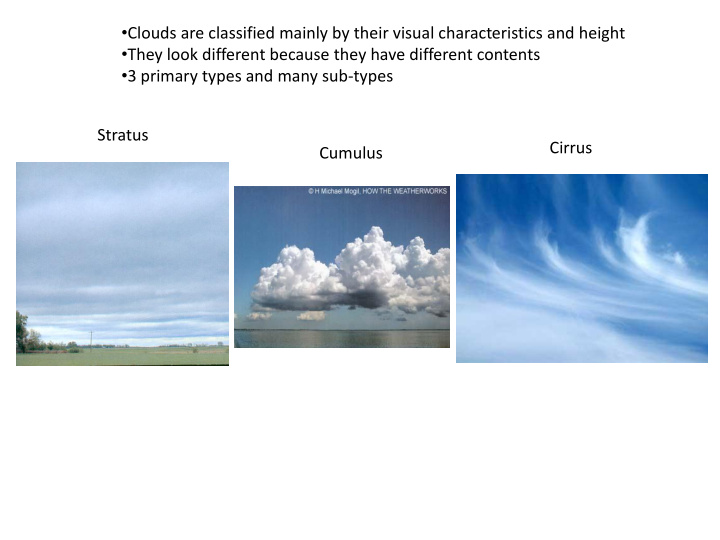



• Clouds are classified mainly by their visual characteristics and height • They look different because they have different contents • 3 primary types and many sub-types Stratus Cirrus Cumulus
Stratus Clouds Characteristics: • Can be at any altitude – stratus just means that they form a horizontal layer • They are often at low altitude in bad weather (nimbostratus) • Fog is a stratus cloud hugging the ground • They are formed by weak, but widespread vertical motion (~10 cm/s) • The are made of a moderate density of cloud drops , LWC~.1 g/m 3 • Cumulus or cirrus can also form a layer (Stratocumulus and cirrostratus)
Cumulus Clouds Characteristics: • Can be at any altitude – cumulus means “heaping” • They develop more vertically than horizontally. • When they form rain they become cumulonimbus • They are formed by strong vertical motion, sometimes 25 m/s updrafts • Strong vertical motion and cumulus clouds result from free convection that comes from instability • If that vertical motion is deep enough, ice can form in upper part of the cloud • Ice crystals and strong motion -> charge separation ->lightning • They have the greatest LWC: from .5 to 4 g/m 3 depending of updraft rate
Cirrus Clouds Characteristics: • Are composed of tiny ice crystals, not liquid cloud drops • Usually form only when T< -25 C • They are formed by weak vertical motion (~5 cm/s) • The are made of a small density of ice crystals , IWC~.05 g/m 3 • Sometimes generated by jet exhaust (contrail) • Often initiated as anvils of cumulus clouds striking the tropopause-lid • Important effects due to widespread radiative impact
Cloud Height Cloud height Cloud types Low (below 2 km, 6500 ft) Fog Stratus Nimbostratus Stratocumulus Stratus fractus Cumulus humulis Mammatus Funnel Middle(2-6 km, 6500-20000ft) Cumulus humulis Cumulus mediocris Stratocumulus Altostratus Altocumulus High (6+ km, 20000 ft+ ) Cirrus Cirrostratus Cirrus uncinus/fibratus Pileus cloud Large vertical span Cumulus castellanus Cumulus congestus Cumulonimbus
http://apollo.lsc.vsc.edu/classes/met130/notes /chapter5/graphics/drop_cloud_ccn.gif CCN: Cloud Condensation Nuclei • Needed to turn supersaturation into liquid drops (a site is needed for condensation) • This is referred to as “drop nucleation” – a big uncertainty in the science of clouds • CCN are preferentially hydrophillic • Can be composed of dust, bacteria, pollen, pollutants, acid drops, salt, and others • Ice nuclei have slightly different characteristics
Vapor deposition into water drops m = “net” molecules added molecules impinging - molecules vaporizing Will make it in Made it out Will be rejected Cloud Drop ~20 um radius m = - - +
Vapor deposition onto ice surfaces • Average coefficients help determine net mass growth rate • Relative local coefficients determine habit type • Local coefficient is a function of temperature and moisture density • Mechanism for coefficient temperature function is an enduring mystery • Mechanism of incorporating incident molecule into lattice is also unknown On the way out Brief layover Cleared for landing Taxiing to lattice (condensation) (surface diffusion) m= Taking off - (sublimation) Actively growing terrace - + 2D Nucleation
Bergeron-Findeison Process • The saturation vapor over water is greater than ice (see phase diagram) • This is caused by the greater difficulty in breaking 100% vs 80% of H-bonds • Vapor tries to move from high concentration -> low concentration (law of diffusion) • Thus, when water and ice surfaces are nearby, the vapor moves from high concentration (water surface)->lower concentration (ice surface), allowing ice to grow as water evaporates • This is the major form of ice crystal growth in mixed-phase clouds • This process contributes to many stages of the precip. process
Little drops->Big drops: Collision-Coalescence
Riming->graupel->Hail
Frozen precip. scenarios
Crystals photographed in cirrus clouds by aircraft-borne probe
Weather Modification and cloud seeding Witches concoct a brew to summon a hailstorm . “After the bomb, Dad came up with ice” – Kurt Vonnegut, Cat’s Cradle , on the invention of “ice - nine”.
Recommend
More recommend